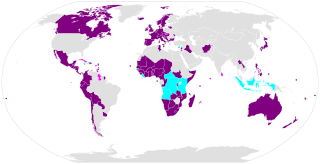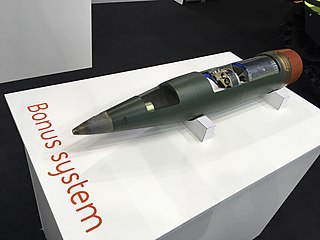
A cluster munition is a form of air-dropped or ground-launched explosive weapon that releases or ejects smaller submunitions. Commonly, this is a cluster bomb that ejects explosive bomblets that are designed to kill personnel and destroy vehicles. Other cluster munitions are designed to destroy runways or electric power transmission lines.

A mortar is usually a simple, lightweight, man-portable, muzzle-loaded weapon, consisting of a smooth-bore metal tube fixed to a base plate with a lightweight bipod mount and a sight. Mortars launch explosive shells in high-arching ballistic trajectories. Mortars are typically used as indirect fire weapons for close fire support with a variety of ammunition.

The CBU-97 Sensor Fuzed Weapon is a United States Air Force 1,000-pound (450 kg)-class freefall Cluster Bomb Unit. It was developed and produced by Textron Defense Systems. A CBU-97 used in conjunction with the Wind Corrected Munitions Dispenser guidance tail kit is converted to a precision-guided weapon, and the combination is designated CBU-105.

BL755 is a cluster bomb developed by Hunting Aircraft that contains 147 parachute-retarded high explosive anti-tank (HEAT) submunitions. Its primary targets are armoured vehicles and tanks with secondary soft target capabilities. It entered service with the Royal Air Force (RAF) in 1973.

A dual-purpose improved conventional munition (DPICM) is an artillery or surface-to-surface missile warhead designed to burst into submunitions at an optimum altitude and distance from the desired target for dense area coverage. The submunitions use both shaped charges for the anti-armor role, and fragmentation for the antipersonnel role, hence the nomenclature "dual-purpose". Some submunitions may be designed for delayed reaction or mobility denial (mines). The air-to-surface variety of this kind of munition is better known as a cluster bomb. They are banned by more than 100 countries under the Convention on Cluster Munitions.

A guided bomb is a precision-guided munition designed to achieve a smaller circular error probable (CEP).

The Instalaza C90 is a 90 mm disposable, shoulder-fired and one-man operated rocket-propelled grenade launcher (RPG) which can be fitted with a VN38-C night vision device for full night combat capability. It is being used as an infantry-type weapon, with Instalaza also claiming it to be the, "lightest infantry weapons system in its class".
The CBU-87 Combined Effects Munition (CEM) is a cluster bomb used by the United States Air Force, developed by Aerojet General/Honeywell and introduced in 1986 to replace the earlier cluster bombs used in the Vietnam War. CBU stands for Cluster Bomb Unit. When the CBU-87 is used in conjunction with the Wind Corrected Munitions Dispenser guidance tail kit, it becomes much more accurate, and is designated CBU-103.

The Convention on Cluster Munitions (CCM) is an international treaty that prohibits all use, transfer, production, and stockpiling of cluster munitions, a type of explosive weapon which scatters submunitions ("bomblets") over an area. Additionally, the convention establishes a framework to support victim assistance, clearance of contaminated sites, risk reduction education, and stockpile destruction. The convention was adopted on 30 May 2008 in Dublin, and was opened for signature on 3 December 2008 in Oslo. It entered into force on 1 August 2010, six months after it was ratified by 30 states. As of December 2023, a total of 124 states are committed to the goal of the convention, with 112 states that have ratified it, and 12 states that have signed the convention but not yet ratified it.

A precision-guided munition is a guided munition intended to precisely hit a specific target, to minimize collateral damage and increase lethality against intended targets. During the First Gulf War guided munitions accounted for only 9% of weapons fired, but accounted for 75% of all successful hits. Despite guided weapons generally being used on more difficult targets, they were still 35 times more likely to destroy their targets per weapon dropped.
The MAT-120 cargo bomb is a Spanish-produced cluster munition, fired from a 120mm calibre mortar produced by Instalaza SA. The main body of the round holds dual-purpose anti-tank/anti-personnel submunitions. The MAT-120 submunitions are unique in that to prevent the dangers of unexploded duds, there is a double redundant feature the manufacturer refers to as self-destruction and self-sterilization. This prevents unexploded MAT-120 submunitions from lying around becoming de facto landmines, dangerous to both combatants and non-combatants.
The SMArt 155 is a German 155 mm artillery round designed for a long-range, indirect fire top-attack role against armoured vehicles. The projectile was developed in 1989 by Diehl BGT Defence in Überlingen, Germany, with Rheinmetall and started full-rate production for the German Army in 1998. It consists of a 47-kilogram (104 lb) heavy artillery projectile containing two autonomous, sensor-fused, "fire-and-forget" submunitions. Due to the submunitions, it has been considered by some to be a cluster munition. As of 2008, representatives of the German defense ministry have referred to it as not being classified as submunition weapons, which were prohibited by the 2008 Convention on Cluster Munitions.

The Soviet 240 mm mortar M240 is a 240 millimeter breech loading smoothbore heavy mortar that fires a 130 kilogram projectile.

The BONUS or ACED is a 155 mm artillery cluster round co-developed and manufactured by Bofors of Sweden and Nexter of France. It was designed to fulfill a long range, indirect fire, top attack requirement against armoured fighting vehicles.

A loitering munition is a kind of aerial weapon with a built-in munition (warhead), which can loiter around the target area until a target is located; it then attacks the target by crashing into it. Loitering munitions enable faster reaction times against hidden targets that emerge for short periods without placing high-value platforms near the target area and also allow more selective targeting as the attack can be changed mid-flight or aborted.

On February 28, 2022, a series of rocket strikes by the Russian Armed Forces killed 9 civilians and wounded 37 more during the battle of Kharkiv, part of the 2022 Russian invasion of Ukraine. The Russian Army used cluster munition in the attack. Due to the indiscriminate nature of these weapons used in densely populated areas, Human Rights Watch described these strikes as a possible war crime.
The most significant using of incendiary weapons were used a number of times during the Russo-Ukrainian War. Russians were accused of using white phosphorus bombs multiple times; in the Battle of Kyiv and against Kramatorsk in March 2022, against dug-in defenders at the Azovstal steel plant in Mariupol in May 2022, and in Marinka over the 2022 Christmas holiday. White phosphorus is a toxic chemical, and exposure to vapors leads to long-term ailments of the body, up to permanent disfigurement and death through organ failure.

On 15 April 2022, a series of rocket strikes by the Russian Armed Forces killed 9 civilians and wounded 35 more during the battle of Kharkiv, part of the 2022 Russian invasion of Ukraine. The Russian Army used 9N210/9N235 cluster munition in the attack. Due to the indiscriminate nature of these weapons when used in densely populated areas, Amnesty International described these strikes as a possible war crime.
In late November and early December 2022, a number of letter bombs were mailed to locations across Spain. Packages were received at high-profile individuals and locations, including the Prime Minister of Spain's Moncloa residence, the Ukrainian and U.S. embassies in Madrid, Torrejon Air Base, and the arms manufacturer Instalaza. One person was injured in the attacks—a security officer at the Ukrainian embassy in Madrid.

The use of cluster munitions during the Russian invasion of Ukraine (2022–present) has been recorded by a number of eyewitnesses and journalists, as well as representatives of the UN, humanitarian and public organizations. In particular, the head of the UN Human Rights Council, Michelle Bachelet, reported on March 30 at least 24 cases since the beginning of the invasion. As of July 1, hundreds of attacks by Russian forces with cluster munitions have already been recorded in the settlements of the Dnipropetrovsk, Donetsk, Zaporizhzhia, Kyiv, Luhansk, Mykolaiv, Odesa, Sumy, Kharkiv, Kherson and Chernihiv regions. 215 civilians are known to have been killed in these shellings and 474 injured, many of which may go unreported. Both Russia as well as Ukraine have used cluster munitions during the conflict, however, Russian use has been extensive while Ukrainian use has been more limited.
















